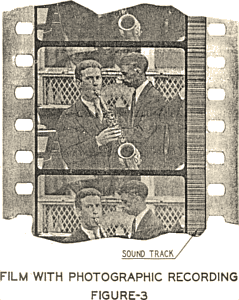I N T R 0 D U C T I 0 N
Page 4
the contrast between light and dark lines, the louder the sound. Such a film is called a sound film, and is otherwise similar to an ordinary film. After leaving the lower sprocket of the projector head, the sound film enters the reproducing apparatus, where it passes over a sprocket that moves it along at constant speed. A narrow bright beam of light from a high intensity exciting lamp is focused on the sound track of the film through a system of lenses and a slit in an aperture plate. The light which has passed through the moving film will then vary in intensity according to the variations of the lines recorded on the sound track. This light falls on a photoelectric cell, which produces a small electric current whose variations correspond to the light, and therefore to the sound which was recorded. The small current from the electrical reproducer or the photoelectric cell passes along to one or more vacuum tube amplifiers (Figs. 4, 5, & 5A) similar in principle to those used in the audiofrequency stages of radio sets; these amplifiers deliver a greatly magnified copy of this current. The current from the amplifiers is converted into sound by means of sound projectors consisting of receivers and horns (Fig. 6), located at the screen. Usually a special type of screen is employed, which reflects light well and enables a good picture to be obtained, but is practically transparent to sound waves. The horns are placed immediately behind the screen so that a perfect illusion that the sound is coming from the speaker or other source seen on the screen is obtained in all parts of the house. Obviously if the sound is not coming directly from the screen, the illusion is lost.
In the disc method, synchronism between sound and picture is assured by having the projector and the turntable carrying the record both driven by the same motor; hence if the film and record are started together they must necessarily keep in step throughout the remainder of the reel. In the film method the fact that the sound record is on the same film with the picture makes synchronism inherent provided that the film is set up with the proper loops to ensure that when a picture is at the picture aperture in the projector head, the accompanying portion of the sound track will be at the light aperture in the reproducing mechanism.
By using two projectors alternately, a continuous program can be run just as with ordinary pictures. This is accomplished by turning a knob on a device known as a fader (Fig. 7), at the same time that the changeover is made from one reel to the next. At the end of each record or sound

